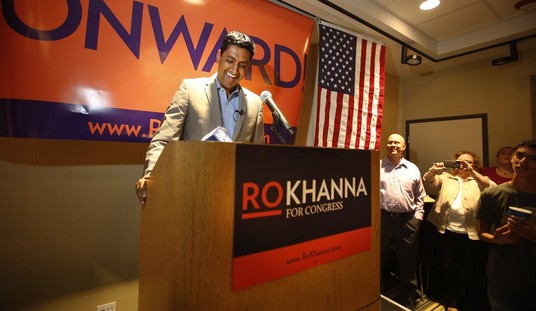Sometimes the greatest blame comes from great praise when viewed in hindsight. The Los Angeles Times proves that with an article from 1999 heaping praise on the very people most responsible for the credit-market meltdown. Ronald Brownstein lauded the Clinton administration for boosting minority ownership by forcing lenders to offer better terms to marginally-qualified borrowers — and noted the financial creativity from Fannie Mae and Freddie Mac as a crucial component of Bill Clinton’s efforts. It also demonstrates why Congress mandated the failure of the lending system, and why it has to act to fix it (via Hot Air reader abinitoadinfinitum):
It’s one of the hidden success stories of the Clinton era. In the great housing boom of the 1990s, black and Latino homeownership has surged to the highest level ever recorded. The number of African Americans owning their own home is now increasing nearly three times as fast as the number of whites; the number of Latino homeowners is growing nearly five times as fast as that of whites.
These numbers are dramatic enough to deserve more detail. When President Clinton took office in 1993, 42% of African Americans and 39% of Latinos owned their own home. By this spring, those figures had jumped to 46.9% of blacks and 46.2% of Latinos.
Most people would agree that higher home-ownership rates are a positive sign in any community. They indicate investment in a community and commitment as well. Property owners have more of a stake in their cities and towns, and also typically support property rights in general.
But how was this accomplished? Here’s where that praise turns to condemnation (emphases mine):
Under Clinton, bank regulators have breathed the first real life into enforcement of the Community Reinvestment Act, a 20-year-old statute meant to combat “redlining” by requiring banks to serve their low-income communities. The administration also has sent a clear message by stiffening enforcement of the fair housing and fair lending laws. The bottom line: Between 1993 and 1997, home loans grew by 72% to blacks and by 45% to Latinos, far faster than the total growth rate.
Requiring banks to serve their low-income communities. That’s shorthand for taking on more risk and lowering what had been standard prerequisites for purchasing homes. Normally, lenders would have demanded at least 10% down, and preferred 20%, and demonstration of stable income, of which the mortgage payments would not exceed 30%. Under threat of prosecution for bigotry, lenders had to start taking less-qualified borrowers as clients.
But the government had a way for them to spread that risk throughout the investment community:
Lenders also have opened the door wider to minorities because of new initiatives at Fannie Mae and Freddie Mac–the giant federally chartered corporations that play critical, if obscure, roles in the home finance system. Fannie Mae and Freddie Mac buy mortgages from lenders and bundle them into securities; that provides lenders the funds to lend more.
In 1992, Congress mandated that Fannie and Freddie increase their purchases of mortgages for low-income and medium-income borrowers. Operating under that requirement, Fannie Mae, in particular, has been aggressive and creative in stimulating minority gains. It has aimed extensive advertising campaigns at minorities that explain how to buy a home and opened three dozen local offices to encourage lenders to serve these markets. Most importantly, Fannie Mae has agreed to buy more loans with very low down payments–or with mortgage payments that represent an unusually high percentage of a buyer’s income. That’s made banks willing to lend to lower-income families they once might have rejected.
Got that? Congress told the two government-sponsored enterprises (GSEs), Fannie Mae and Freddie Mac, to buy up the paper and transform these marginally-qualified loans into what’s known as mortgage-backed securities (MBS). The purchase of these loans made them much more attractive to lenders, who rushed to create more of them. Fannie and Freddie then kept buying the paper and turning them into MBSs and selling them to investors, who assumed that the government would back the GSE securities Congress mandated into existence.
Thanks to this massive intervention in the lending marketplace, what followed was utterly predictable for anyone who had ever completed Econ 101 at a junior college:
- The massive influx of new home buyers drove up housing prices.
- The rising prices pushed borrowers and lenders into adjustable-rate mortgages to allow the purchase of homes for no down, on the premise that the rising prices (which reacted to massive new demand) would allow them to refinance before the ARMs adjusted to their maximum, at which point borrowers would refinance with the new-found equity as their down payment to get better rates and lower monthly payments they could afford.
- Housing prices rose so quickly that builders invested in new houses on a massive scale to produce inventory to meet the demand.
- As long as prices continued to rise, and as long as the two GSEs kept issuing the MBSs, investors kept buying them — with their government backing.
All of this depended on a steady and significant increase in housing prices — which came to an end late last year. When prices fell, an entire class of overextended borrowers could no longer refinance their ARMs to get affordable mortgage payments, and they began to default. As I wrote earlier, it was similar to the margin calls in 1929, only in slower motion. The bottom fell out of the housing market, and thanks to the massive sale over the previous decade of MBSs based on marginal loans, the collapse didn’t just get limited to the lenders or the borrowers, but investors around the world.
I’ve written this a couple of times, but this LA Times article from 1999 makes the case clearly — and maybe even more credibly, since it praises all of the stupidity and government intervention that created the bubble and the collapse. Clearly, this was not the fault of a free market out of control. Congress and the executive created this problem by extorting banks into poorly-considered lending practices under the threat of prosecution as “unfair lenders”. They compounded that extortion with an artificial mechanism to incentivize lenders by having GSEs buy the paper and resell it, with government imprimatur as its guarantee.
Normally, I’d say let the lenders drown. Unfortunately, this isn’t completely their fault, and we should have known better. Not too many of us complained about the rapid escalation of our own equity that came from this housing/lending bubble, and in the end most of us will still benefit from it, if not quite as much as it seemed a year ago. Three years ago, Alan Greenspan tried to get Congress to act, and only John McCain, Chuck Hagel, John Sununu, and Elizabeth Dole responded — while politicians of both parties made sure to keep the Ponzi scheme in full swing. And those MBSs were minted at the behest of Congress, the people’s branch of government. We broke it, and we own it.
Government created this problem, and government will have to provide at least part of the solution. What we need is a way to make sure that government doesn’t interfere in lending markets again. We need to eliminate GSEs entirely and let borrowers and lenders find each other in the marketplace. If government would quit trying to pick winners and losers, we wouldn’t find ourselves in this grave financial crisis.
Update: SeeJaneMom has further comments on this article, although I think the situation is less dire than she does.







Join the conversation as a VIP Member